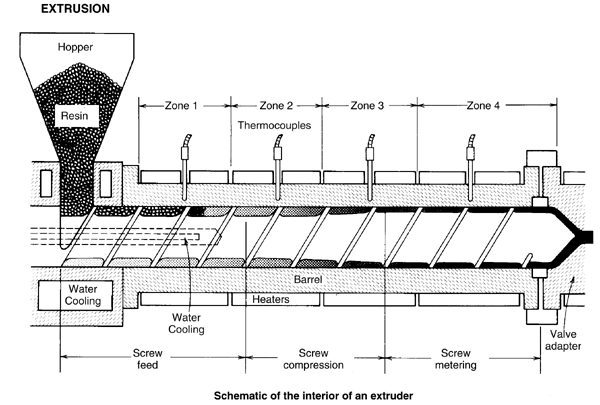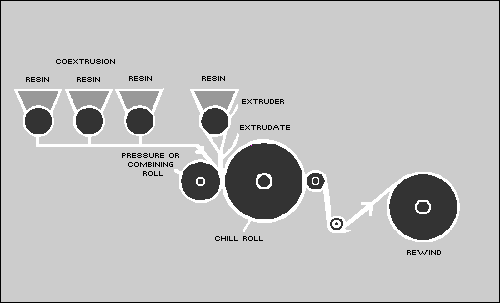





Note: The following index list will take you to separate articles pertaining to the specific subject.
return to Plastic Information and Processes
Introduction:
Extrusion is one of the most common plastics processing techniques covering a vast range of applications in which resins are melted, heated and pumped for processing. Extrusion machines accomplish these tasks by means of one or more internal screws.
In extrusion, the material to be processed is sheared between the root of the screw and the wall of the barrel that surround it. This process produces frictional energy that heats and melts the substance as it is conveyed down the barrel.
Melted extrudite from the machine is further processed after the extrusion phase, which typically produces pellets, sheet, cast film, blown film, fibers, coatings, pipes, profiles or molded parts.
Sheet extrusion is a variation of this process where continuous sheets of plastic are extruded in various widths for forming and other secondary processing.
Profile extrusion is used to make vinyl window parts, building products including baseboard, straws, tubing of all kinds. Most commonly extruded material is PVC, although most plastic resins can be processed. Melt index (viscosity) must be fairly high.
Most commonly used pipe materials (rigid PVC, ABS, HDPE)
Extrusion Coating is used to produce a thin film for coating on paper, foils, fabric, or some other substrate material. The coating typically is 0.0002 to 0.015 inch thick, and the substrate materials typically are 0.0005 to 0.024 inch thick.
Wire coating is one of the oldest extrusion processes for thermoplastics. The die used on a wire coating extruder is unique, as a wire must pass through the die for coating.
Fibers have been produced from thermoplastics for some time. The materials used in normal fiber spinning operations are of lower viscosity than their blow molding, profile, or blown film counterparts. Materials commonly used for making fibers include polypropylene, nylon, and polyesters.
Process:
Molten plastic is forced or extruded directly out of the barrel through a die horizontally to form a continuous, long line of plastic. It goes through a trough of cool water for hardening and is then cut to length.
Sheet extrusion is a variation of this process where continuous sheets of plastic are extruded in various widths for vacuum forming and other secondary processing.
Pipe and tubing extrusion are produced from similar die designs, as the pipe exits the die, it is pulled through a cooling and sizing apparatus.
In wire coating, the bare wire is unwound from a reel and fed through the extrusion die. The coated wire then runs through a cooling trough for solidification of the polymer.
Fiber polymers are extruded at fairly high melt temperatures into a piping manifold with a series of melt pumps. Each melt pump feeds a spinnerette, which is a die with many small circular orifices. The fine melt strands produced are pulled from the die and cool rapidly. As the fibers are pulled farther downstream, they are oriented in the machine direction to impart good tensile strength.


Banks of extruders can be used together, the first set creating a coextruded substrate and subsequent extruders depositing more layers onto the original. This is another way to combine resins with very different melting points.
![]() Return to the Enginnering Resource Center Home Page. (ERC)
Return to the Enginnering Resource Center Home Page. (ERC)